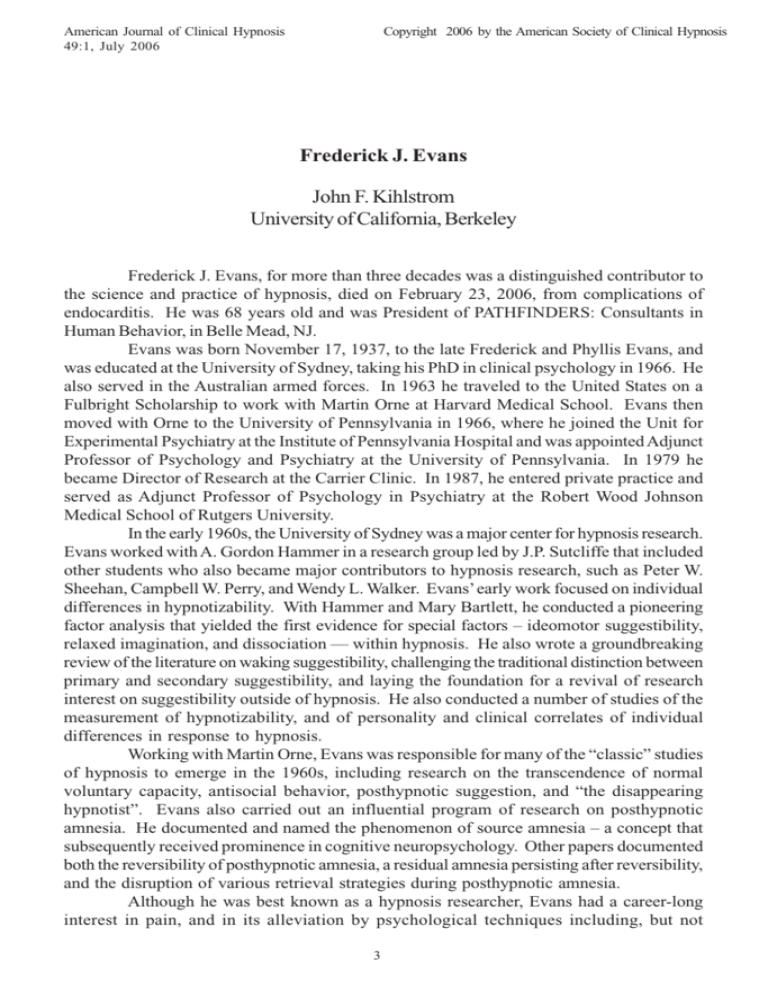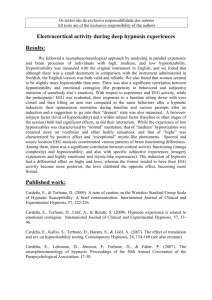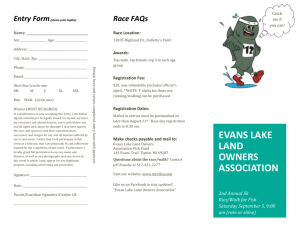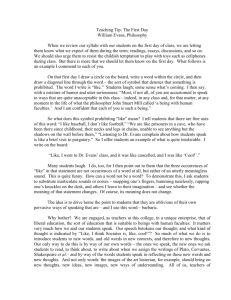Frederick J. Evans John F. Kihlstrom University of California, Berkeley
advertisement

American Journal of Clinical Hypnosis 49:1, July 2006 Copyright 2006 by the American Society of Clinical Hypnosis Frederick J. Evans John F. Kihlstrom University of California, Berkeley Frederick J. Evans, for more than three decades was a distinguished contributor to the science and practice of hypnosis, died on February 23, 2006, from complications of endocarditis. He was 68 years old and was President of PATHFINDERS: Consultants in Human Behavior, in Belle Mead, NJ. Evans was born November 17, 1937, to the late Frederick and Phyllis Evans, and was educated at the University of Sydney, taking his PhD in clinical psychology in 1966. He also served in the Australian armed forces. In 1963 he traveled to the United States on a Fulbright Scholarship to work with Martin Orne at Harvard Medical School. Evans then moved with Orne to the University of Pennsylvania in 1966, where he joined the Unit for Experimental Psychiatry at the Institute of Pennsylvania Hospital and was appointed Adjunct Professor of Psychology and Psychiatry at the University of Pennsylvania. In 1979 he became Director of Research at the Carrier Clinic. In 1987, he entered private practice and served as Adjunct Professor of Psychology in Psychiatry at the Robert Wood Johnson Medical School of Rutgers University. In the early 1960s, the University of Sydney was a major center for hypnosis research. Evans worked with A. Gordon Hammer in a research group led by J.P. Sutcliffe that included other students who also became major contributors to hypnosis research, such as Peter W. Sheehan, Campbell W. Perry, and Wendy L. Walker. Evans’ early work focused on individual differences in hypnotizability. With Hammer and Mary Bartlett, he conducted a pioneering factor analysis that yielded the first evidence for special factors – ideomotor suggestibility, relaxed imagination, and dissociation — within hypnosis. He also wrote a groundbreaking review of the literature on waking suggestibility, challenging the traditional distinction between primary and secondary suggestibility, and laying the foundation for a revival of research interest on suggestibility outside of hypnosis. He also conducted a number of studies of the measurement of hypnotizability, and of personality and clinical correlates of individual differences in response to hypnosis. Working with Martin Orne, Evans was responsible for many of the “classic” studies of hypnosis to emerge in the 1960s, including research on the transcendence of normal voluntary capacity, antisocial behavior, posthypnotic suggestion, and “the disappearing hypnotist”. Evans also carried out an influential program of research on posthypnotic amnesia. He documented and named the phenomenon of source amnesia – a concept that subsequently received prominence in cognitive neuropsychology. Other papers documented both the reversibility of posthypnotic amnesia, a residual amnesia persisting after reversibility, and the disruption of various retrieval strategies during posthypnotic amnesia. Although he was best known as a hypnosis researcher, Evans had a career-long interest in pain, and in its alleviation by psychological techniques including, but not 3 Frederick J. Evans limited to, hypnosis. Although he was involved in groundbreaking research demonstrating the independence of hypnotic analgesia from the placebo response, he remained convinced that placebos revealed important psychosomatic processes, and could be harnessed for appropriate clinical use. Following his discovery that response to placebo analgesia was a constant fraction of the effect of the active medication to which the placebo was compared, Evans became a widely cited authority on the placebo response, and on pain control generally. He argued that every active treatment had a placebo component that could be capitalized on to improve patient outcomes. Partly as an offshoot of his interest in hypnosis, Evans was an important contributor to the literature on sleep. At a time when most sleep researchers focused on the physiology of the various sleep stages, Evans argued that the psychological and behavioral aspects of sleep should be studied as well. Together with other colleagues in Orne’s laboratory, he conducted provocative research on sleep learning, and on behavioral responses to suggestions administered during sleep. Although sleep reflects an endogenous biological rhythm, he was particularly interested in the self-regulation of sleep, and in the role that hypnosis, or hypnotizability, might play in the successful treatment of sleep disorders. Australia, of course, was the home base of Ainslie Meares, a pioneer of clinical hypnosis. Trained as a researcher, Evans was always concerned with the applications to research in clinical practice. This is obvious from his work on pain, but also extended to other topics. His earliest research, for example, foreshadowed the more recent revival of interest on dissociative processes. He also believed that hypnotizability might play a predispositional role in certain forms of psychopathology, and also moderate patients’ response to psychotherapy. Accordingly, he conducted research on hypnotizability in different diagnostic groups, and encouraged clinicians to assess their patients’ level of hypnotizability. Evans’ contributions to hypnosis were widely recognized by his peers. He served on the editorial boards of the American Journal of Clinical Hypnosis, Australian Journal of Clinical and Experimental Hypnosis, and International Journal of Clinical and Experimental Hypnosis. He served as President of Division 30 (Psychological Hypnosis) of the American Psychological Association, the Society for Clinical and Experimental Hypnosis, and the International Society of Hypnosis. He received a number of awards from SCEH, including the Henry Guze Award for Best Research Paper (1974 and 1978) and the Arthur Shapiro Award for Best Book on Hypnosis (1980). Evans’ first marriage, to Barbara J. Marcelo Evans, ended in divorce. A son, Mark Evans, predeceased him. He is survived by his wife, Patricia “Pepper” Evans, of Lawrenceville, N.J.; three daughters, Diana, Mariefred, and Ellen; two sons, Christopher and David; and his brother, Reginald. 4







